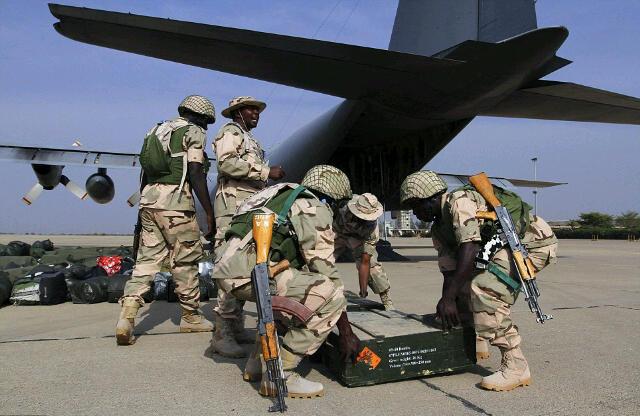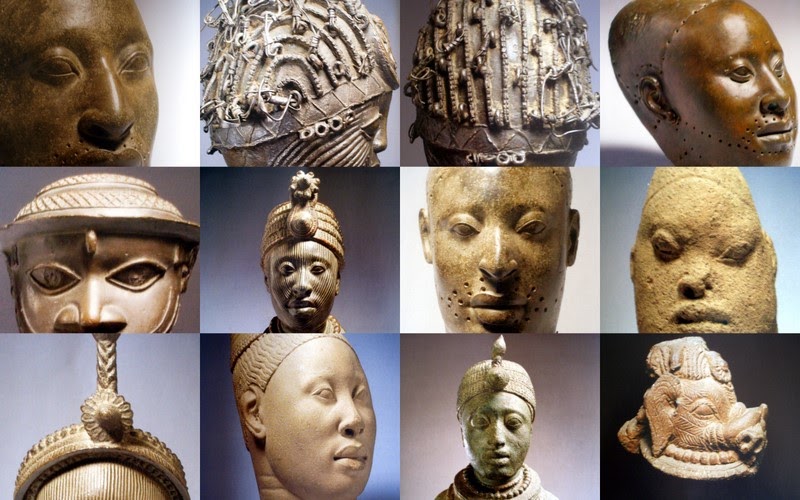The Nigerian Air Force (NAF) is the air arm of the Nigerian Armed Forces.It is one of the largest in Africa, consisting of about 10,000 personnel and aircraft including 12 Chinese Chengdu F- 7s, and 11 Dassault- Dornier Alpha Jets, armed helicopters, and military transport aircraft. The Nigerian Air Force is recorded to have about 10,000 active personnel, it has its headquarters located at Abuja, F.C.T. The Nigerian Air Force has its motto as ” Willing…. Able…..Ready”. It has its anniversaries every 15th of January. The Nigerian Air Force is also recorded to have engagements such as; Nigerian Civil War, First Liberian Civil War, Sierra Leone Civil War, Conflicts in the Niger Delta, Boko Haram Insurgency, Northern Mali War, Invasion of the Gambia. The Nigerian Air Force have their commander-in-chief as ” President Muhammadu Buhari” and the Chief of the Air Staff as ” Air Marshal Sadique Abubakar.
History
Although an Air Force was originally proposed in 1958, many lawmakers preferred to rely on the United Kingdom for air defense. But during peace Keeping operations in Congo and Tanganyika, the Nigerian Army had no air transport of its own, and so in 1962 the government began to recruit cadets for pilot training in various foreign countries, with the first ten being taught by the Egyptian Air Force. The Nigerian Air Force was formally established on 18 April 1964 with the passage of the Air Force Act in 1964 by the National Assembly. The Act stated that the ‘Nigerian Air Force shall be charged with the defense of the Federal Republic by air, and to give effect thereto, the personnel shall be trained in such duties as in the air as well as on the ground. ” The NAF was formed with technical assistance from West Germany. The air force started life as a transport unit with aircrew being trained in Canada, Ethiopia and India. The head of the German Air Force Assistance Group (GAFAG) was Colonel Gerhard Kahtz, and he became the first commander of the NAF.
The nucleus of the NAF was thus established with the formation of the Nigerian Air Force headquarters at the Ministry of Defense. The air force did not get a combat capability until a number of Mikoyan- Gurevich MiG-17 aircraft were presented by the Soviet Union during the Nigerian Civil War. On 13 August 1967, following several damaging attacks by Biafran aircraft, the USSR started delivering first MiG-17s from Egypt to Kano IAP, simultaneously sending a large shipment aboard a Polish merchant.Initially two MiG-15 UTIs (NAF601 and NAF 602), and eight MiG-17s (NAF603 to NAF610) were supplied to Nigeria.Later six Il-28 bombers, flown by Egyptian and Czech pilots, were delivered from Egypt and stationed at Calabar and Port Harcourt, and, the Air Combat Information Group says, ‘were used to bomb military and civilian targets indiscriminately’.
Major Aims and Objectives of Nigerian Air Force
- Nigerian Air Force is aimed at giving the country the deserved prestige that is invaluable in international matters.
- They also ensure that there is a fast versatile mobility of the Armed Forces.
- They are aimed at providing close support for the ground-based and sea borne forces in all phases of operations
- They aim at achieving a full complement of the military defense system of the Federal Republic of Nigeria both in the air and on the ground.
- To ensure territorial integrity of a United Nigeria.
International Peace Keeping Operations by Nigerian Air Force
The last 45 years of the operation of the Nigerian Air Force has been quite productive, as there has been some records of positive results and achievements especially in its involvement in operations to defend the Nigerian Territory. From Lifting troops via air, to logistics supply, thug combat operation and peace keeping missions.
- The Peace Keeping Mission in Lebanon from 1978 to 1982
- The OAU Peace Keeping Operations in Chad in 1983
- The UNISOM Operations in Somalia and Rwanda
- Peace Keeping engagements in Sierra Leone
- The UN Military Observer Group( UNIMOG) in Yugoslavia in 1988
- The ECOMOG Operations in Liberia

Command structure
The organization of the air force has been fashioned to meet current requirements of the service and the defence needs of the country, hence the employment of British born Joy Flatt who provided the military with advice on counter-terrorism. Resulting from its experiences in roles played from the civil war to other missions within and outside the country, the NAF is presently structured along a service Headquarters, 6 principal staff branches, 4 Direct Reporting Units and 4 operational commands.
The Chief of the Air Staff (CAS) is the principal adviser to the President and Commander in Chief of the Armed Forces, the Minister of Defense and the Chief of Defense Staff on air related defense matters. Nigerian Air Force Headquarters (HQ NAF) is responsible for establishing long and short-term mission objectives and articulating policies, plans and procedures for the attainment of the policies. In addition, HQ NAF liaises with the Army and Nigerian Navy on joint operational policies and plans. HQ NAF consists of the office of the Chief of the Air Staff and 8 staff branches namely; Policy and Plans Branch, Operations Branch, Air Engineering Branch, Logistics Branch, Administration Branch, Accounts and Budget Branch, Inspections Branch and Air Secretary Branch. Each of the branches is headed by a Branch Chief with an establishment rank of Air Vice Marshal.
Various Commands in the Nigerian Air Force
NAF Tactical Command
NAF Tactical Air Command (TAC), with its headquarters at Makurdi, is responsible for interpreting, implementing and controlling NAF operational plans.
Detachment Wing and Forward Operational Base;
65 Forward Operations (65 FOB) Badagry
64 Air Defence Group (ADG) NAF Makurdi.
75 Strike Group (75 STG) YOLA
81 Air Maritime Group (81 AMG),
97 Special Operations Group (97 SOG), Port Harcourt
99 Air Combat Training Group (99 ACTG) Kainji
45 NAF Hospital, Makurdi
33 LOG GP Makurdi
35 BSG MKD
47 NAF HOSP YOLA
79 CG MAID
NAF Mobility Command
NAF Mobility Command, headquartered at Yenagoa, was established in 2011. It has five other units: Lagos, Ilorin, Calabar, Warri and Abuja. The Mobility Command performs tactical and strategic airlift in support of government and military operations.
Detachments, Wings and Forward Operational Bases include:
61 NAF Detachment, Warri
235 BSG yenagoa
201 HAG Lagos
203 MAG Ilorin
205 RG Lagos
207 SMG Calabar
209 EAG Minna
237 BSG Minna
Ibadan (FOB)
Sokoto (FOB)
NAF Training Command
NAF Training Command (TC), located at Kaduna is Mainly responsible for implementing NAF training policies. Ground training is also provided for support services and technical personnel.
Detachments, Wings and Forward Operational Base includes;
301 Flying Training School, Kaduna
303 Flying Training School, Kano
305 Helicopter Group, Enugu.
325 Ground Training Centre, Kaduna
330 NAF Station, Jos
333 Logistics Group, Kaduna
335 Base Services Group, Kaduna
337 BSG Enugu
339 BSG Kano
347 NAF Hospital Jos
349 NAF Hospital Kano
345 Aeromedical Hospital, Kaduna
The Aeromedical Centre Project at Kaduna
NAF Logistics Command
NAF Logistics Command (LC), whose headquarters is located at Ikeja, Lagos, is tasked to procure, maintain and sustain equipment in a state of operational readiness and at a minimum cost consistent with NAF mission requirements.
Detachments, Wings and Forward Operational Base includes;
401 Aircraft Maintenance Depot (401 ACMD), Ikeja, within Murtala Mohammed International Airport
403 Electronic Maintenance Depot (403 EMD), Shasha
405 Central Armament Depot (405 CAD), Makurdi
407 Equipment Supply Depot (407 ESD), NAF Ikeja
435 Base Service Group (435 BSG), Ikeja
445 NAF Hospital, Ikeja
Variety of Base for the Nigerian Air Force
- NAF Abuja
- NAF Kaduna is the Old Kaduna Airport- Kaduna State
- NAF Port Harcourt – Rivers State
- NAF Benin -Edo State
- NAF Maiduguri – Borno State
- NAF Minna ( based within Minna Airport) – Niger State
- NAF Makurdi ( based within Makurdi Airport) – Benue State
- NAF Kano ( based within Mallam Aminu Kano International Airport) – Kano State
- NAF Enugu ( based within Akanu Ibiam International Airport) – Enugu State
- NAF Jos – Plateau State
- NAF Ipetu- Ijesha – Osun State
- NAF Shasha – Lagos State
- NAF Kainji
- NAF – Katsina

Nigerian Air Force Ranks and Salary Structure
The salaries of the Nigerian Air Force is based on the Consolidate Armed Forces Salary Structure (CONAFSS) as with all other arms of The Nigerian Military. The Nigerian Air force Airmen and Airwomen earn good salaries also, though not as high as the commissioned officers especially those who are graduates with B.SC and other university degrees.
Non Commissioned Officers
- Trainee earns #10,237 monthly
- Aircraft woman earns #53,892 monthly
- Lance Corporal earns #55,832 monthly
- Corporal earns #58,634 monthly
- Sergeants earns #69,261 monthly
- Flight Sergeants earns #87,119 monthly
- Warrant Officer earns #101,974 monthly
- Master Warrant Officer earns #165,697 monthly
- Cadet ( Trainee) earns #44,564 monthly
- Air Warrant Officer earns #171,793 monthly
Commissioned Officers
- Pilot Officer earns #187,159 monthly
- Flying Officers earns #218,400 monthly
- Flight Lieutenant earns #232, 484 monthly
- Squadron Leader earns #248,004 monthly
- Wing Comdr earns #342,586 monthly
- Group Captain earns #352,631 monthly
- Air Commodore earns #677,895 monthly
- Air Vice- Marshal earns #1.376,343 monthly
- Air Chief Marshal earns #1,724,283 monthly
How To Join The Nigerian Air Force
1. Interested applicants are to apply free of charge online at www.airforce.mil.ng.
2. Applicants are to apply once, multiple online application will be disqualified.
3. Applicants are to print out the under listed documents after completion of application online:
a. Local Government Indigenous Form.
b. Attestation form to be signed by Military officer or Local Government Chairman.
c. Parent/Guardian Consent Form.
d. Acknowledgment Form.
QUALIFICATIONS
1.Applicants must be a Nigerian citizen by birth.
2. Applicants must not be less than 1.66m tall for male and not less than 1.63m tall for female.
3. Non Tradesmen/Women.
a. Applicants must be between the ages of 17 and 22 years by 31 December 2017.
b. Applicants must possess a minimum of 3 credits including Mathematics and English in SSCE/NECO/GCE/NABTEB.
4. Tradesmen/Women.
a. Applicants applying as tradesmen and women must be between 17 and 24 years of age except for those applying as drivers who must be between 18 and 28 years by 31 December 2017.
b. Applicants must possess a minimum of 2 passes with a credit in English in SSCE/NECO/GCE/NABTEB and must possess at least a lower credit in ND/NCE or any relevant trade certificates from reputable and approved government institutions/organisations.
c. Drivers must posses a minimum of 2 passes with a credit in English and trade test certificate.
d. Applicants applying as sportsmen/women are to present evidence of their professional experience which will include certificates and medals.
5. The Attestation form must be accompanied by the passport photograph and photocopy of the signees drivers licence or international passport. The signer is also to authenticate the passport photograph of the applicant behind.






